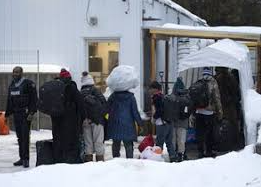
Refugees Return to Roxham Road as Canada Ends COVID-Era Ban
Migrants are once again heading to Canada seeking asylum after the country lifted a 20-month ban on such requests, originally imposed to curb the spread of COVID-19.
At the Greyhound station in Plattsburgh, New York, taxi drivers wait to ferry passengers on a short drive to Roxham Road, a snowy dead-end dirt road leading to the Canadian border. Here, groups of refugees arrive daily, greeted by Royal Canadian Mounted Police officers who inform them of the illegality of their crossing. Despite this, most migrants are promptly released and allowed to pursue their asylum claims while living and working freely in Canada.
Alejandro Cortez, a 25-year-old Colombian refugee, was among those arriving last week. Standing at the border, he expressed hope for a better future. “We all dream of success and a chance to change our lives,” he said, explaining he fled Colombia to escape violence and social unrest.
Policy Shift Contrasts with U.S. Approach
Canada’s decision to reopen the asylum process on November 21 starkly contrasts with the United States, where similar restrictions under Title 42 remain in effect. This U.S. policy, invoked in March 2020, has resulted in nearly 1.5 million expulsions, denying migrants the opportunity to seek asylum under the pretext of pandemic-related public health concerns.
The lifting of Canada’s asylum ban has seen a significant rise in border crossings, particularly at Roxham Road, a well-known point of entry for migrants bypassing official crossings. In November, 832 people sought asylum in Quebec compared to just 96 in October.
Migrants entering Canada through unofficial crossings like Roxham Road benefit from a loophole in the 2002 Safe Third Country Agreement between the U.S. and Canada. This agreement requires asylum seekers to apply in the first country they enter, but it applies only to official ports of entry. Thus, those crossing at non-official locations are allowed to remain in Canada and apply for protection.
Asylum Trends and Responses
Since February 2017, nearly 60,000 individuals have entered Canada illegally to seek asylum, with Roxham Road serving as a primary entry point. Canadian government data reveals that over 45,000 claims have been processed, with approximately 54% approved.
Unlike in Canada, the U.S. approach has faced intense criticism from international bodies, legal experts, and advocacy groups. Critics argue that the Title 42 policy lacks a solid scientific foundation and violates international asylum laws.
Janet McFetridge, a member of Plattsburg Cares, has witnessed the recent surge of migrants at Roxham Road. “People are crossing quickly, fearing the border might shut again,” she said.
At the border, a Canadian officer reiterated the legal consequences to a woman carrying a baby: “If you cross here, you will be arrested.” Her reply was calm yet determined: “Yes, it’s not a problem.” Moments later, her companion pulled a suitcase across the snowy divide, embodying the resilience and urgency of those seeking a new beginning.




















Comments
Hello world!
Pic of the week: Sunset at margate beach
The first day’s journey was through the pink fields
The first day’s journey was through the pink fields
The first day’s journey was through the pink fields